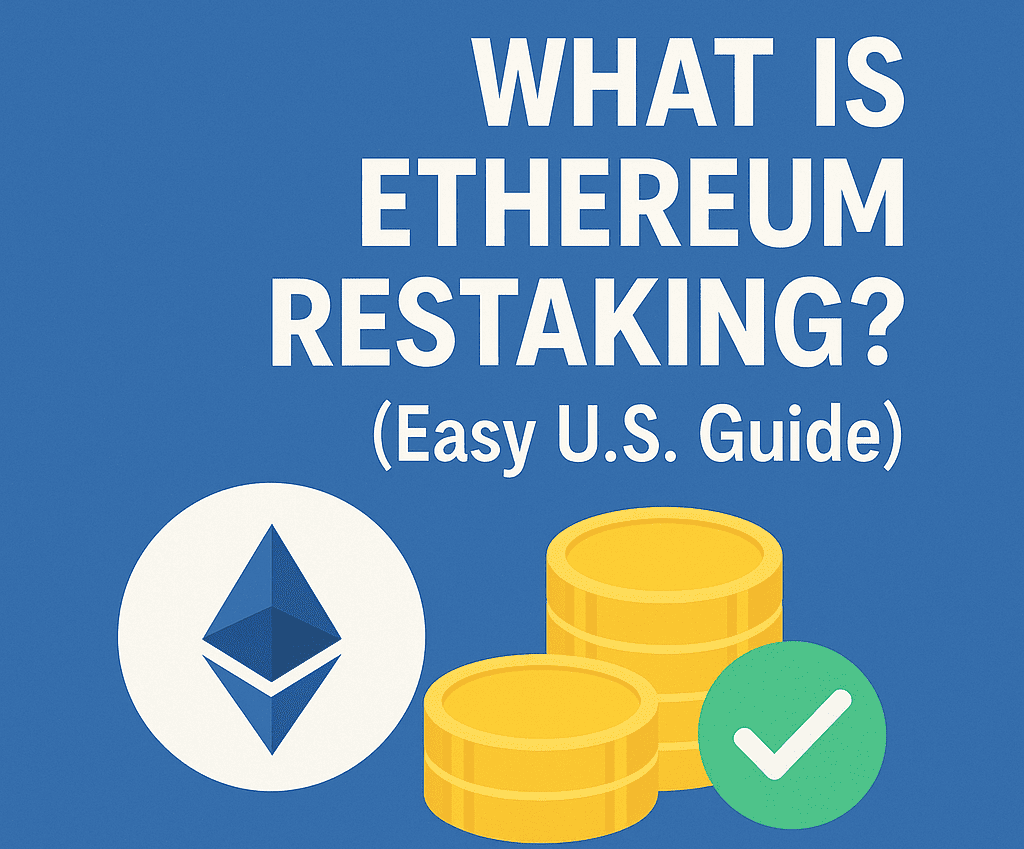What is Ethereum Restaking? (Easy U.S. Guide)
By Abhishek Chandravanshi

Cryptocurrency evolves fast — and Ethereum is always at the center of the action. First came staking with Ethereum 2.0. Now, a new opportunity is buzzing in the crypto world: Ethereum restaking.
If you’re wondering “What is Ethereum Restaking? (Easy U.S. Guide)” — you’re in the right place.
In this easy-to-understand U.S.-focused guide, we’ll break down what Ethereum restaking is, how it works, why it matters, and how you can get started. Plus, we’ll cover the risks you should know about, top platforms to explore, and how restaking compares to traditional ETH staking.
Let’s dive in!
Featured Snippet Outline:
Q: What is Ethereum Restaking?
A: Ethereum restaking allows users to reuse their staked ETH to secure additional networks beyond Ethereum, earning extra rewards. It builds on regular staking, offering more earning opportunities through protocols like EigenLayer, while still supporting the Ethereum blockchain.
What Is Ethereum Restaking?
At its core, Ethereum restaking means using your already staked ETH to secure additional networks and earn more rewards — without unstaking it from Ethereum.
Normally, when you stake ETH, you’re helping secure the Ethereum blockchain.
With restaking, you can “reuse” that staked ETH to also help secure other blockchain services, such as new decentralized protocols, bridges, or rollups. In exchange, you earn extra rewards on top of your Ethereum staking yield.
Think of it like:
- You stake your ETH once.
- Then, you “restake” it to do even more work — and get paid more for it.
The leading platform offering restaking right now is EigenLayer, a protocol built on Ethereum that allows stakers to opt into providing security for other decentralized services.
Why Is Ethereum Restaking Important?
Ethereum restaking is important because it:
- Boosts Earnings: Earn more without needing to stake new funds.
- Strengthens Security: Smaller projects can tap into Ethereum’s trust layer.
- Promotes Innovation: New services and blockchains grow faster by borrowing security.
- Maximizes Efficiency: Puts idle capital (staked ETH) to better use.
For users, it’s about earning more passive income. For developers, it’s about building faster without creating massive new validator networks from scratch.
How Does Ethereum Restaking Work?
Here’s a simplified step-by-step of how Ethereum restaking works:
- Stake ETH: First, you stake ETH either directly or through liquid staking platforms (like Lido, Rocket Pool, or Coinbase).
- Choose Restaking: Opt into restaking platforms like EigenLayer. You’ll delegate your staked ETH or liquid staking token (e.g., stETH) to participate.
- Secure New Networks: Your restaked ETH is now helping secure additional decentralized services.
- Earn Extra Rewards: In addition to Ethereum staking rewards, you receive incentives from the new services you’re supporting.
Important: You’re still exposed to slashing risks. If the services you secure get attacked, you could lose part of your staked ETH.
Platforms Offering Ethereum Restaking
1. EigenLayer
- Pioneer of the Ethereum restaking model.
- Allows you to opt-in and secure “Actively Validated Services” (AVS).
- Supports restaking from both native ETH and liquid staking tokens.
Explore how staking works on EigenLayer ➝ (Internal: link to your CryptoTrendd staking calculator page if available.)
Ethereum Staking vs Restaking: Key Differences
| Feature | Regular Staking | Restaking |
|---|---|---|
| Purpose | Secure Ethereum blockchain | Secure Ethereum + other services |
| Rewards | Base Ethereum staking APY | Base rewards + bonus rewards |
| Risk | Ethereum validator risk | Ethereum + additional protocol risks |
| Platforms | Exchanges, staking pools | Restaking protocols (EigenLayer) |
✅ Restaking = more earning opportunities, but slightly more risk.
Pros and Cons of Ethereum Restaking
Pros:
- Higher potential yield
- Supports decentralized innovation
- Capital efficiency: No need to unstake
Cons:
- Higher risk: Slashing across multiple protocols
- Complexity: New systems might be confusing
- Limited platforms: Only a few trusted restaking options
How to Get Started with Ethereum Restaking (U.S. Users)
Here’s your easy roadmap:
Step 1: Stake Your ETH
You must have staked ETH, either directly (running your own validator) or through platforms like:
Step 2: Choose a Restaking Provider
Sign up on restaking services like EigenLayer (note: it’s still rolling out to U.S. users depending on regulations).
Step 3: Delegate Your Staked ETH
Use your stETH, rETH, or cbETH to restake.
Step 4: Earn and Monitor
Track your restaking rewards and stay updated on new protocols you’re securing.
Is Ethereum Restaking Safe?
Ethereum restaking is relatively safe if you understand the risks:
- Slashing Risk: If the protocol you secure gets compromised, your staked ETH could be slashed (reduced).
- Smart Contract Risk: If restaking smart contracts are buggy, funds could be lost.
- Regulatory Risk: Especially in the U.S., regulations could affect participation.
Best practices:
- Only use reputable restaking platforms.
- Stay diversified — don’t put all your ETH into one restaking service.
- Regularly monitor updates from your platform.
The Future of Ethereum Restaking
Restaking could redefine DeFi and blockchain security.
By letting projects “borrow” Ethereum’s security, innovation could accelerate dramatically — without needing every new protocol to bootstrap its own validator set.
In the coming years, expect:
- More restaking platforms
- Higher yields
- More liquid restaking tokens
- Expanded regulatory frameworks
Ethereum restaking is just getting started.
FAQs About Ethereum Restaking
1. What is Ethereum Restaking? (Easy U.S. Guide)
Ethereum restaking allows users to reuse their staked ETH to secure additional networks and earn extra rewards. It enhances your staking income but carries added risks.
2. Can I restake with liquid staking tokens like stETH?
Yes, most restaking platforms support liquid staking tokens such as stETH (from Lido), rETH (from Rocket Pool), or cbETH (from Coinbase).
3. Is Ethereum restaking available for U.S. residents?
It depends. EigenLayer and other services are gradually opening to U.S. users based on regulatory approvals. Always check availability.
4. How much more can I earn with restaking?
Exact APYs vary by service. Some early restakers are seeing bonus yields of 2-10%+ on top of normal ETH staking rewards.
5. What are the risks of restaking?
Key risks include slashing, smart contract vulnerabilities, and regulatory changes. Always research and consider diversifying your holdings.
Conclusion: Should You Try Ethereum Restaking?
If you already stake ETH and want to maximize passive income, Ethereum restaking is worth considering — with caution.
Remember:
- Only restake with trusted platforms.
- Understand the extra risks.
- Diversify where possible.
In a fast-growing world of decentralized finance, restaking gives you an early mover advantage — earning more from the assets you already hold.
Want to start optimizing your staking yields today?
Check out our Crypto Staking Calculator ➝ to estimate how much you could earn with Ethereum restaking!
🎯 Related Articles:
Still have questions about Ethereum restaking? Drop them in the comments — we’re here to help you earn smarter! 🚀
